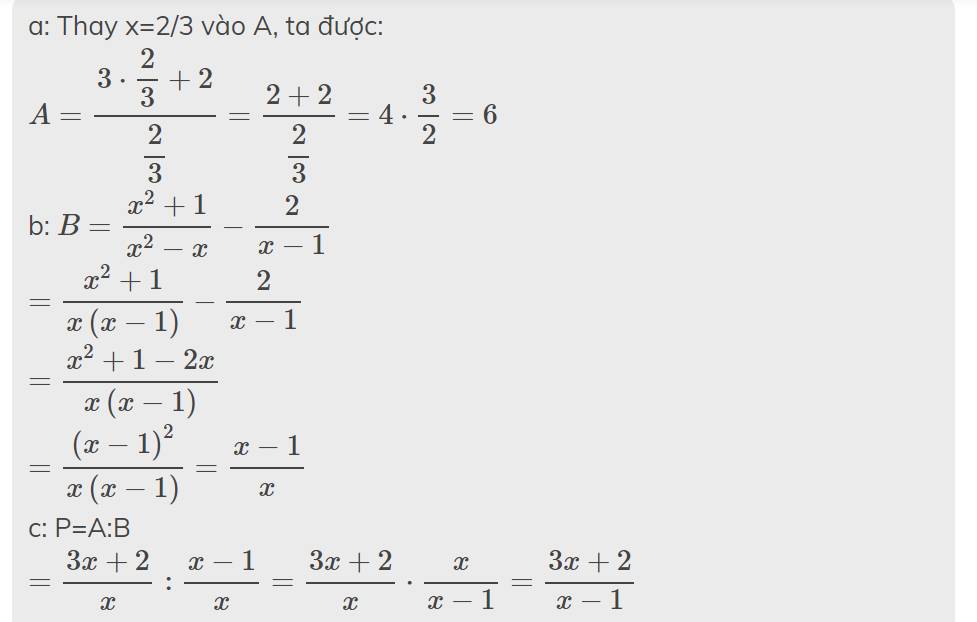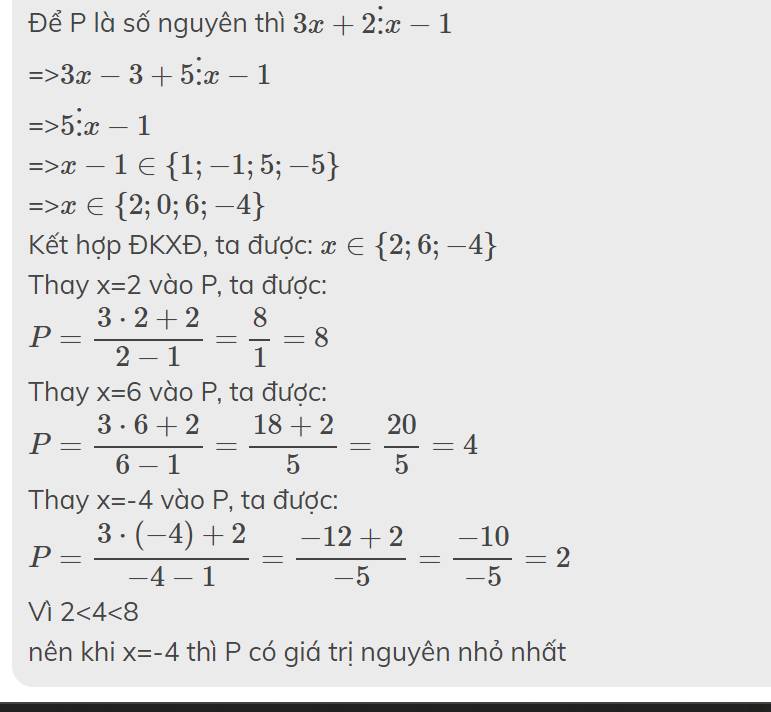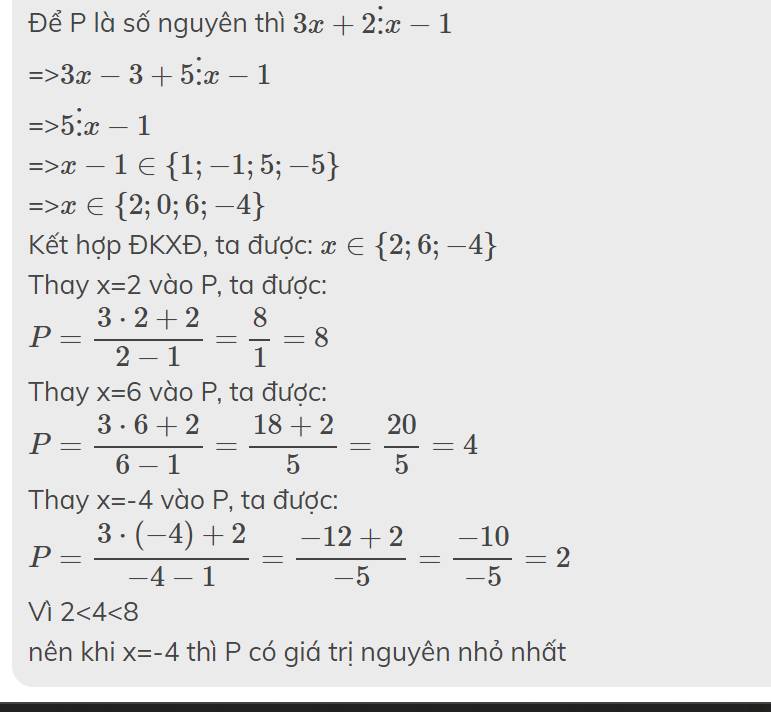
Hãy nhập câu hỏi của bạn vào đây, nếu là tài khoản VIP, bạn sẽ được ưu tiên trả lời.



a: Thay x=2/3 vào A, ta được:
\(A=\dfrac{3\cdot\dfrac{2}{3}+2}{\dfrac{2}{3}}=\dfrac{2+2}{\dfrac{2}{3}}=4\cdot\dfrac{3}{2}=6\)
b: \(B=\dfrac{x^2+1}{x^2-x}-\dfrac{2}{x-1}\)
\(=\dfrac{x^2+1}{x\left(x-1\right)}-\dfrac{2}{x-1}\)
\(=\dfrac{x^2+1-2x}{x\left(x-1\right)}\)
\(=\dfrac{\left(x-1\right)^2}{x\left(x-1\right)}=\dfrac{x-1}{x}\)
c: P=A:B
\(=\dfrac{3x+2}{x}:\dfrac{x-1}{x}=\dfrac{3x+2}{x}\cdot\dfrac{x}{x-1}=\dfrac{3x+2}{x-1}\)
Để P là số nguyên thì \(3x+2⋮x-1\)
=>\(3x-3+5⋮x-1\)
=>\(5⋮x-1\)
=>\(x-1\in\left\{1;-1;5;-5\right\}\)
=>\(x\in\left\{2;0;6;-4\right\}\)
Kết hợp ĐKXĐ, ta được: \(x\in\left\{2;6;-4\right\}\)
Thay x=2 vào P, ta được:
\(P=\dfrac{3\cdot2+2}{2-1}=\dfrac{8}{1}=8\)
Thay x=6 vào P, ta được:
\(P=\dfrac{3\cdot6+2}{6-1}=\dfrac{18+2}{5}=\dfrac{20}{5}=4\)
Thay x=-4 vào P, ta được:
\(P=\dfrac{3\cdot\left(-4\right)+2}{-4-1}=\dfrac{-12+2}{-5}=\dfrac{-10}{-5}=2\)
Vì 2<4<8
nên khi x=-4 thì P có giá trị nguyên nhỏ nhất

BÀI 1:
a) \(ĐKXĐ:\) \(x-3\)\(\ne\)\(0\)
\(\Leftrightarrow\)\(x\)\(\ne\)\(3\)
b) \(A=\frac{x^3-3x^2+4x-1}{x-3}\)
\(=\frac{\left(x^3-3x^2\right)+\left(4x-12\right)+11}{x-3}\)
\(=\frac{x^2\left(x-3\right)+4\left(x-3\right)+11}{x-3}\)
\(=x^2+4+\frac{11}{x-3}\)
Để \(A\)có giá trị nguyên thì \(\frac{11}{x-3}\)có giá trị nguyên
hay \(x-3\)\(\notinƯ\left(11\right)=\left\{\pm1;\pm11\right\}\)
Ta lập bảng sau
\(x-3\) \(-11\) \(-1\) \(1\) \(11\)
\(x\) \(-8\) \(2\) \(4\) \(14\)
Vậy....

d) \(A>0\Leftrightarrow\frac{-1}{x-2}>0\)
\(\Leftrightarrow x-2< 0\) ( vì \(-1< 0\))
\(\Leftrightarrow x< 2\)
\(A=\left(\frac{x}{x^2-4}+\frac{2}{2-x}+\frac{1}{x+2}\right):\left(x-2+\frac{10-x^2}{x+2}\right)\)
\(A=\)\(\left[\frac{x}{\left(x-2\right)\left(x+2\right)}-\frac{2\left(x+2\right)}{\left(x-2\right)\left(x+2\right)}+\frac{x-2}{\left(x-2\right)\left(x+2\right)}\right]\)
\(:\left[\frac{\left(x-2\right)\left(x+2\right)}{x+2}+\frac{10-x^2}{x+2}\right]\)
\(A=\frac{x-2x-4+x-2}{\left(x-2\right)\left(x+2\right)}:\left[\frac{x^2-4+10-x^2}{x+2}\right]\)
\(A=\frac{-6}{\left(x-2\right)\left(x+2\right)}:\frac{6}{x+2}\)
\(A=\frac{-6}{\left(x-2\right)\left(x+2\right)}.\frac{x+2}{6}\)
\(A=\frac{-1}{x-2}\)

a) \(A=\frac{2x}{x+3}+\frac{2}{x-3}+\frac{x^2-x+6}{9-x^2}\left(x\ne\pm3\right)\)
\(\Leftrightarrow A=\frac{2x}{x+3}+\frac{2}{x-3}-\frac{x^2-x+6}{x^2-9}\)
\(\Leftrightarrow A=\frac{2x}{x+3}+\frac{2}{x-3}-\frac{x^2-x+6}{\left(x-3\right)\left(x+3\right)}\)
\(\Leftrightarrow A=\frac{2x\left(x-3\right)}{\left(x-3\right)\left(x+3\right)}+\frac{2\left(x+3\right)}{\left(x-3\right)\left(x+3\right)}-\frac{x^2-x+6}{\left(x-3\right)\left(x+3\right)}\)
\(\Leftrightarrow A=\frac{2x^2-6x+2x+6-x^2+x-6}{\left(x-3\right)\left(x+3\right)}\)
\(\Leftrightarrow A=\frac{x^2-3x}{\left(x-3\right)\left(x+3\right)}=\frac{x\left(x-3\right)}{\left(x+3\right)\left(x-3\right)}=\frac{x}{x+3}\)
Vậy \(A=\frac{x}{x+3}\left(x\ne\pm3\right)\)
b) Ta có \(A=\frac{x}{x+3}\left(x\ne\pm3\right)\)
Để A nhạn giá trị nguyên thì \(\frac{x}{x+3}\)nhận gái trị nguyên
Ta có \(\frac{x}{x+3}=\frac{x+3-3}{x+3}=1-\frac{3}{x+3}\)
=> \(\frac{3}{x+3}\)nguyên thì \(1-\frac{3}{x+3}\)nguyên
=> 3 chia hết cho x+2.
x nguyên => x+3 nguyên => x+3\(\inƯ\left(3\right)=\left\{-3;-1;1;3\right\}\)
Ta có bảng
| x+3 | -3 | -1 | 1 | 3 |
| x | -6 | -4 | -2 | 0 |
Đối chiếu điều kiện x\(\ne\pm3;x\inℤ\)
=> x={-6;-4;-2;0}
Vậy x={-6;-4;-2;0} thì A nhận giá trị nguyên

a)
Để A nguyên \(\Leftrightarrow x^3+x⋮x-1\)
\(\Leftrightarrow x^3-1+x+1⋮x-1\)
\(\Leftrightarrow\left(x-1\right)\left(x^2+x+1\right)+x+1⋮x-1\left(1\right)\)
Vì x nguyên \(\Rightarrow\hept{\begin{cases}x-1\in Z\\x^2+x+1\in Z\end{cases}}\)
\(\Rightarrow\left(x-1\right)\left(x^2+x+1\right)⋮x-1\left(2\right)\)
Từ (1) và (2) \(\Rightarrow x+1⋮x-1\)
\(\Leftrightarrow x-1+2⋮x-1\)
Mà \(x-1⋮x-1\)
\(\Rightarrow2⋮x-1\)
\(\Rightarrow x-1\inƯ\left(2\right)=\left\{\pm1;\pm2\right\}\)
\(\Rightarrow x\in\left\{-1;0;2;3\right\}\)
Vậy \(x\in\left\{-1;0;2;3\right\}\)
b) Để B nguyên \(\Leftrightarrow x^2-4x+5⋮2x-1\)
\(\Leftrightarrow2x^2-8x+10⋮2x-1\)
\(\Leftrightarrow\left(2x^2-x\right)-\left(6x-3\right)-\left(x-7\right)⋮2x-1\)
\(\Leftrightarrow x\left(2x-1\right)-3\left(2x-1\right)-\left(x-7\right)⋮2x-1\)
\(\Leftrightarrow\left(2x-1\right)\left(x-3\right)-\left(x-7\right)⋮2x-1\left(1\right)\)
Vì x nguyên \(\Rightarrow\hept{\begin{cases}2x-1\in Z\\x-3\in Z\end{cases}}\)
\(\Rightarrow\left(2x-1\right)\left(x-3\right)⋮2x-1\left(2\right)\)
Từ (1) và(2) \(\Rightarrow x-7⋮2x-1\)
\(\Leftrightarrow2x-14⋮2x-1\)
\(\Leftrightarrow2x-1-13⋮2x-1\)
Mà \(2x-1⋮2x-1\)
\(\Rightarrow13⋮2x-1\)
\(\Rightarrow2x-1\inƯ\left(13\right)=\left\{\pm1;\pm13\right\}\)
Làm nốt nha các phần còn lại bạn cứ dựa bài mình mà làm




\(A=\dfrac{x+2}{x^2-x+3}\Leftrightarrow Ax^2-Ax+3A=x+2\\ \Leftrightarrow Ax^2-x\left(A+1\right)+3A-2=0\\ \Leftrightarrow\Delta=\left(A+1\right)^2-4A\left(3A-2\right)\ge0\\ \Leftrightarrow-11A+10A+1\ge0\\ \Leftrightarrow-\dfrac{1}{11}\le A\le1\)
Mà \(A\in Z\Leftrightarrow A\in\left\{0;1\right\}\)
\(+)A=0\Leftrightarrow x+2=0\Leftrightarrow x=-2\\ +)A=1\Leftrightarrow x+2=x^2-x+3\Leftrightarrow x=1\)
Vậy \(x\in\left\{-2;1\right\}\Leftrightarrow A\in Z\)